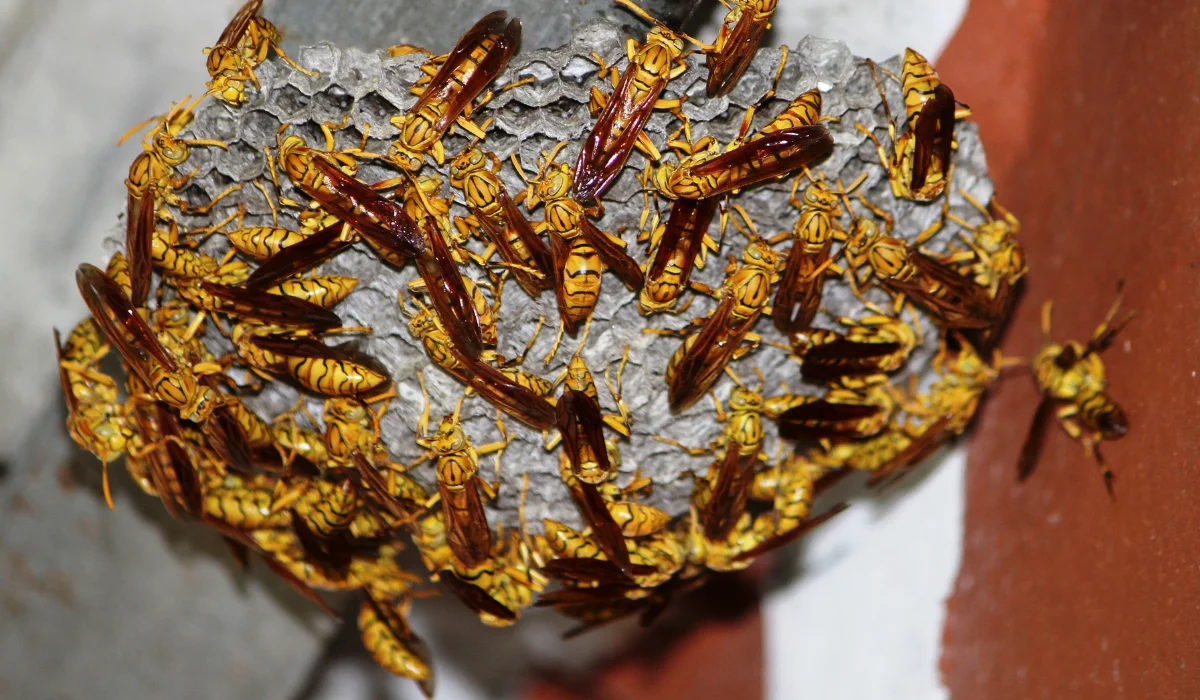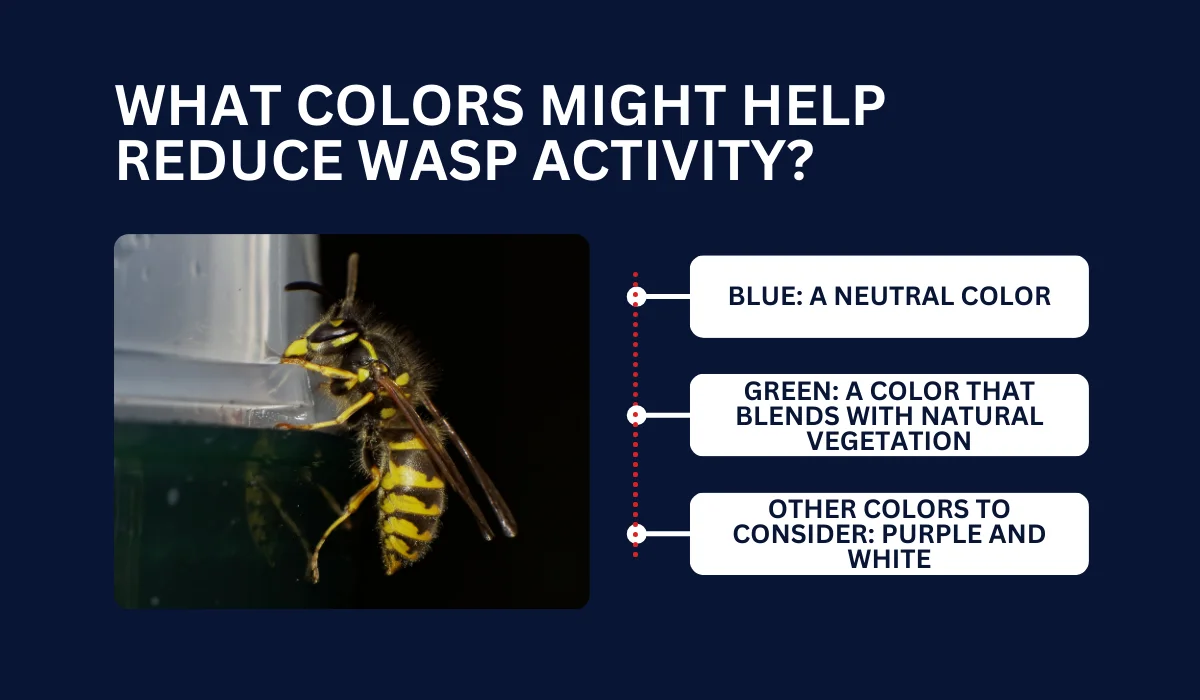
Ever wonder why wasps constantly disrupt your backyard gatherings? Wasps are attracted to certain colors, so understanding their preferences can help you know which colors you might want to avoid.
Curious about which colors are attracting these stinging insects? Keep reading to find out.
Key Takeaways
- Wasps are attracted to bright colors like yellow and red, while some colors like blue might be less appealing, though not necessarily repellent.
- Painting outdoor furniture and decor in blue or darker colors might help reduce wasp activity around your home.
- If colors alone don’t deter wasps, using traps, natural repellents, or contacting a professional are effective alternatives.
- Hiring a professional pest control service is advisable, especially if a severe wasp infestation or someone in the home is allergic to stings.
DO WASPS DISLIKE CERTAIN COLORS?
Different colors can significantly impact wasps’ behavior. While they are generally attracted to bright hues, some colors may be less appealing.
How Wasps See Colors
Species like paper wasps, yellow jackets, and European hornets have compound eyes that allow them to see a broad spectrum of colors.
They are particularly sensitive to the ultraviolet spectrum, which helps them locate food sources in the environment.
This sensitivity allows them to pick up on colors highlighting flowers and prey. Honey bees and other pollinators also respond similarly to certain colors, creating competition and appeal in the wild.
How Colors Affect Wasps
Different colors influence wasps’ behavior, making some areas more or less attractive. Combining color with other deterrents, like strong scents or pheromones, can enhance the effectiveness of these strategies.
These stinging insects are often drawn to colors that signal food sources, such as bright yellows and reds, while other colors may not appeal to them as much. However, note that color alone may not be enough to deter them completely.
WHAT COLORS MIGHT HELP REDUCE WASP ACTIVITY?

Certain colors might help reduce wasp activity, though they are not guaranteed to repel them. Here’s what you need to know:
Blue: A Neutral Color
Blue is thought to be a color that might reduce wasp activity due to their visual perception. Wasps may not distinguish blue as easily as other colors, which could make blue objects less interesting to them.
While blue can be a useful tool in creating less attractive areas for wasps, it should be combined with other deterrents for better results.
Green: A Color That Blends with Natural Vegetation
Green might help reduce wasp activity by blending into the natural environment. However, it is not necessarily a repellent. The color’s ability to blend with vegetation could make green objects less noticeable to wasps, but this effect should not be relied upon exclusively.
Other Colors to Consider: Purple and White
Purple and white might also be less attractive to wasps than brighter hues. While these colors are not proven repellents, they can be used with other strategies to create a less appealing environment for wasps.
White, in particular, might make spaces appear more exposed, which could discourage wasps from lingering, though this is not a guaranteed effect.
WHAT COLORS ATTRACT WASPS?
Wasps are highly attracted to bright colors, particularly yellow and red. They are also drawn to areas where food is abundant, such as gardens filled with flowers or places where trash cans are overflowing.
The Allure of Yellow and Red
Wasps are drawn to bright colors, and yellow, in particular, can entice them. This attraction is due to their visual perception, which allows them to see in the ultraviolet spectrum.
Yellow can mimic the appearance of flowers, leading wasps to associate it with food sources. While not as attractive as yellow, red still catches its attention and can be mistaken for nectar-rich flowers.
The Sweet Scent of Flowers and Food
Beyond bright colors, scents are crucial. Wasps are attracted to places with ample food sources, such as blooming flowers or areas with exposed food and drinks.
This is why they often hover around picnic areas, trash cans, and even certain plants, such as artemisia and pennyroyal.
WHAT TO DO WHEN COLORS DO NOT REPEL WASPS
Sometimes, changing colors isn’t enough to keep wasps away. If color strategies aren’t effective, consider these additional methods to deal with these stingers:
- Set Up Wasp Traps: Place them strategically to catch multiple wasps and keep them away from your living spaces.
- Use Natural Repellents: Mix essential oils like lemongrass, cinnamon, citronella, or peppermint oil with water in spray bottles.
- Combine Aromatic Scents: Wear colognes with cucumber peel or eucalyptus to further discourage wasps.
- Grow Wasp-Repelling Plants: Plant geraniums, marigolds, spearmint, and wormwood to potentially repel wasps due to their odors.
- Consider Using Decoy Nests: Place decoy nests around your property to help keep them away.
- Contact a Professional Exterminator: If the problem persists, call a professional pest control service. They have the expertise and tools to safely and effectively remove wasp nests.
SHOULD YOU HIRE A PROFESSIONAL PEST CONTROL?
You may often wonder when to call pest control for wasp infestations. If someone in the home is allergic to wasp stings, it’s best to get professional help. Wasps can be very aggressive, especially if their nest is disturbed.
Whether you’re in Baton Rouge or New Orleans, seeking expert help should be easy. For immediate intervention for a severe infestation, let Lajaunie’s wasp control specialists tailor a solution that’s right for your home.
For more information about our services, visit our service page.